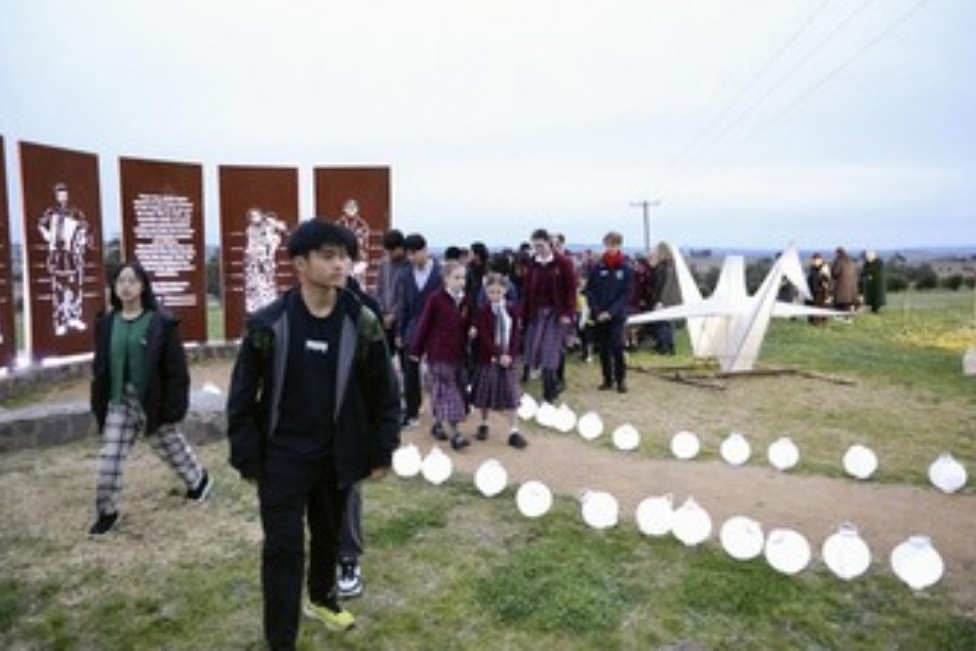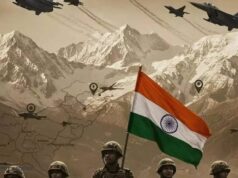Rural Australian town marks 80th anniversary of Japanese POW breakout

Fires are lit at the former prisoner of war camp in Cowra, eastern Australia, on Aug. 5, 2024, at a memorial ceremony marking 80 years since Japanese POWs set fire to the camp in a mass escape attempt. (Kyodo)
The rural Australian town of Cowra on Monday commemorated 80 years since hundreds of Japanese World War II prisoners of war made a daring attempt to escape from an internment camp in the small town.
Just before 2 a.m., a commemorative event on the former campsite in the New South Wales town recreated the moments leading up to the mass escape attempt, known as the Cowra Breakout, on Aug. 5, 1944, including the firing of two warning shots and flares into the sky.

School children from Australia and Japan attend a memorial service on the site of the former prisoner of war camp in Cowra, eastern Australia, on Aug. 5, 2024, marking 80 years since a mass escape attempt by Japanese POWs
The ceremony was attended by family members of the former prisoners of war, Japan’s Parliamentary Vice Foreign Minister Yasushi Hosaka and students from Seikei Gakuen in Tokyo, who are continuing a decades-long exchange program with Cowra High School.
Hosaka, who attended the event on behalf of the Japanese government, spoke to reporters after the ceremony and expressed his gratitude to the people of Cowra, saying they “showed no hostility to Japan and extended a spirit of tolerance and friendship. It was not an easy decision.”
Australian Prime Minister Anthony Albanese visited the graves of the fallen soldiers on Sunday and laid a wreath alongside Japan’s ambassador to Australia, Kazuhiro Suzuki.
“The people of Cowra remind us that no matter what, our common humanity has the power to transcend everything,” Albanese said. “In the wake of the bleakest of nights, Cowra took the ashes of war and tenderly and carefully nourished the roots of friendship.”
Known as the largest prison break staged in modern history, the Cowra Breakout led to the only land battle fought on Australian soil during the war, where more than 230 Japanese troops died after either being shot dead or committing suicide. Four Australian soldiers were also killed during the incident.
Hiroaki Asada, 75, whose father-in-law Shiro Asada was one of the few witnesses to survive the incident, was among those who traveled from Japan to mark the occasion.
Shiro, a former prisoner of war from Shimane Prefecture who died in 2002 at the age of 82, said before his death that the Japanese soldiers despaired of living with the guilt of being enemy prisoners of war and were resolved to “die” at once.
According to Hiroaki, a resident of Hiroshima, Shiro felt indebted to Australia for “forgiving us without punishing us,” and after the war, spent many years interacting with the people of Cowra. Some of his remains were buried in a cemetery in the town in 2004.
Hundred-year-old Cowra local Gwen Downes, one of the last living links to the events of 80 years ago, also attended memorial events on Monday.
Speaking to Kyodo News, Downes recalled how the dramatic events unfolded on her wedding day, delaying the train she had boarded that evening to head to her honeymoon in Sydney as Australian soldiers searched for escaped POWs.
“The train didn’t move from the station, and we were waiting and waiting, but the train in front of us, one had committed suicide under the train, and they were worried that there may be others,” said Downes.

Photo taken March 6, 1946, shows a Japanese prisoner of war injured in the mass escape attempt at Cowra, eastern Australia, lying in an ambulance before being carried onboard a Japanese ship to return home. (Photo courtesy of the Australian War Memorial (126291)) (Kyodo)
Over 1,000 Japanese military personnel were housed in the Cowra POW camp when they attempted to escape by storming the perimeter fences, armed with improvised weapons such as baseball bats and sharpened table knives. They used woolen blankets and wore baseball gloves to protect themselves while climbing over the barbed wire fencing.
In the following days, all 334 prisoners who successfully escaped the compound were either recaptured or, in 25 cases, died.




